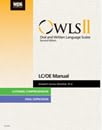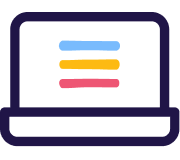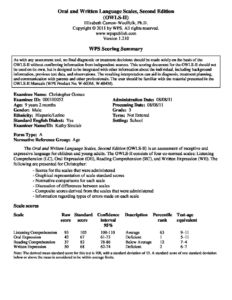
Oral and Written Language Scales - Second Edition owls-ii
For: Provides a complete and integrated picture of oral and written language skills across a wide age range
Reading Level: Ages 3 to 21 years for Listening Comprehension and Oral Expression Scales; Ages 5 to 21 years for Reading Comprehension and Written Expression Scales
Format: Paper-and-Pencil; PC Based Software
Length: 10-20 minutes for Listening Comprehension Scale; 10-30 minutes for Oral Expression Scale; 10-30 minutes for Reading Comprehension Scale; 15-30 minutes for Written Expression Scale
Scoring: Hand Scored; Computer Scored
Printed Manuals
Physical printed manuals.
Online Forms, Reports, Kits & e-Manuals
All online resources including Forms, Reports, i-Admins, Kits and e-Manuals.
Printed Kits
Click to browse products
Books & Workbooks
Click to browse products
Printed Forms & Handscoring Materials
Test forms, response booklets and scoring reference manuals.
PC Software
Click to browse products
OWLS-II LC/OE Manual
OWLS-II LC/OE Online Manual
OWLS-II RC/WE Manual
OWLS-II RC/WE Online Manual
OWLS-II LC Digital Easel A
OWLS-II LC Digital Easel B
OWLS-II OE Digital Easel A
OWLS-II OE Digital Easel B
OWLS-II RC Digital Easel A
OWLS-II RC Digital Easel B
OWLS-II WE Digital Easel A
OWLS-II WE Digital Easel B
OWLS-II Comprehensive Hand Scored Kit
OWLS-II Comprehensive Software Kit
OWLS-II LC/OE – FORM B Pack
OWLS-II LC/OE Hand Scored Kit
OWLS-II LC/OE Software Kit
OWLS-II RC/WE – FORM B Pack
OWLS-II RC/WE Hand Scored Kit
OWLS-II RC/WE Software Kit
OWLS-II LC Easel – FORM B
OWLS-II LC Easel – Form A
OWLS-II OE Easel – FORM B
OWLS-II OE Easel – Form A
OWLS-II RC Easel
OWLS-II RC Easel – FORM B
OWLS-II WE Easel
OWLS-II WE Easel – FORM B
OWLS-II LC/OE Record Form (pack of 25)
OWLS-II LC/OE Record Form – FORM B (pack of 25)
OWLS-II RC/WE Record Form – FORM B (pack of 25)
OWLS-II RC/WE Record Forms (pack of 25)
OWLS-II WE Response Booklet (pack of 25)
OWLS-II WE Response Booklet – FORM B (pack of 25)
OWLS-II Unlimited-use Computer Scoring Software (CD ROM)
Sample Reports
The new features of the OWLS-II include:
Reading Comprehension Scale
Updated Norms – with all scales standardised on the same population
Parallel Forms for re-testing
New Items reflecting curricular standards and grade-level language goals
Improved scoring instructions for the WE Scale
Full colour updated stimulus materials
Alternative correct responses for students who speak African-American English or similar dialect
Expanded interpretive guidelines
Notations indicating the linguistic forms measured by each item
View the OWLS-II Quick Reference Guide
Author
Elizabeth Carrow-Woolfolk, Ph.D
Description
Building on the strong theory and research underpinning the original OWLS, the Second Edition of this highly regarded test offers an integrated, global approach to language assessment. The OWLS-II adds a Reading Comprehension Scale, updated norms, new items, a parallel form, improved scoring guidelines, and full-colour stimulus materials. Moreover, a helpful new handbook, Foundations of Language Assessment, explains the theory upon which the OWLS-II is based, making it easier to understand the test and interpret results. Measuring four language processes – separately and in relation to one another – this Second Edition gives you the most complete, accurate, and useful picture of language skills currently available.
More Than the Sum of its Parts
The OWLS-II evaluates four language processes on four separate scales: Listening Comprehension, Oral Expression, Reading Comprehension, and Written Expression.
Each of these scales assesses four linguistic structures:
Lexical/Semantic
Syntactic
Pragmatic
Supralinguistic
Because it looks at the same linguistic structures across four distinct language processes, the OWLS-II provides an unusually detailed, coherent, and integrated assessment. Although its four scales may be used separately, together they give you a comprehensive score profile that pinpoints language delays, identifies strengths and weaknesses in all areas and guides intervention.
Listening Comprehension and Oral Expression Scales
Together these two scales assess receptive and expressive language in ages 3 to 21 years. Individually administered, both use basals and ceilings to ensure that examinees are given only items that closely approximate their ability levels. Neither scale requires reading on the examinee’s part, and both scales feature colourful, updated artwork that’s balanced in terms of race, gender and physical differences.
The Listening Comprehension Scale uses a convenient easel to measure receptive language. The examiner reads a stimulus word or phrase aloud, and the student responds by indicating one of four pictures that best depicts the meaning of the word. Correct responses are printed on the examiner’s side of the easel and on the Record Form – permitting easy, on-the-spot scoring.
The Oral Expression Scale, with its own handy easel, measures expressive language, requiring the examinee to answer questions, finish sentences, and generate sentences in response to visual and oral prompts. To simplify scoring, common responses (correct and incorrect) are printed on the Record Form. In addition, alternate acceptable responses are now provided to accommodate students who speak African-American English.
Reading Comprehension and Written Expression Scales
The OWLS-II assesses written language on two scales, Reading Comprehension and Written Expression, both for ages 5 to 21 years.
New to the Second Edition, the Reading Comprehension Scale measures the receptive aspects of written language. Because it is based on the same theory and structure as the other OWLS-II scales, it is uniquely effective in identifying language factors that may be impairing or facilitating reading comprehension. It measures the same linguistic structures as the other scales, as well as text structure. Items typically require the student to read a prompt and choose one of four response options. Again, correct responses are conveniently listed on the Record Form and the examiner’s side of the easel.
The Written Expression Scale, which measures the expressive aspects of written language, has been significantly improved in the OWLS-II. Item additions and revisions enhance the scale’s validity and scope, as well as its ability to elicit a variety of responses and assess higher-functioning individuals. In addition, scoring guidelines are now more explicit and provide more detailed results.
This scale uses age-based item sets, rather than basals and ceilings, to ensure that only developmentally appropriate items are administered. Each set includes 14 to 18 items that involve writing tasks similar to those students might encounter in the classroom. Some tasks are open-ended, asking the examinee to complete a story or write a paragraph, for example. Others are structured, requiring the student to fill in blanks or write a dictated sentence. Together, these writing tasks measure the four linguistic structures assessed by the other OWLS-II scales, as well as conventions (spelling, punctuation/capitalisation, letter formation) and text structure (organisation, details, cohesion).
The examiner presents oral, written, and pictorial prompts, and examinees write their answers in a Response Booklet. The Record Form provides brief scoring rules for easy reference, and the Manual supplies detailed instructions and examples, as well as guidelines for a qualitative rating of select items. Each Record Form includes item analysis worksheets, allowing quick and qualitative evaluation of strengths and weaknesses.
A New Parallel Form
The Second Edition introduces a parallel form that allows you to retest students on all scales after a brief interval. Form B, which may be used with examinees ages 5 years and up, makes it easier to monitor language development over time.
Scores in Several Useful Formats
All four scales provide age- and grade-based standard scores, test-age equivalents, grade equivalents, percentile ranks, and descriptive labels (Exceptional, Above Average, Average, Below Average, or Possibly Disordered). Scale scores may be combined to produce five Composites: Oral Language, Written Language, Receptive Language, Expressive Processing, and Overall Language.
The OWLS-II Profile Form – included in Comprehensive Kits and available as a free download – gives you a clear, graphic representation of the examinee’s performance in each area. In addition, the form notes the linguistic structure measured by each item. You may quickly compare the student’s ability across scales, linguistic categories, and even items.
All OWLS-II scales are normed on the same sample of 2,123 subjects, from 3 through 21 years of age and nationally representative in terms of gender, ethnicity, geographic region and parental education. Age-stratified norms are provided at 3-month intervals for ages 3 to 7 years, at 6-month intervals for ages 8 to 12 years, at 1-year intervals for ages 13 to 15 years, and at multi-year intervals for ages 16 years and up.
Optional Computer Scoring and Interpretation
The OWLS-II scoring program converts raw scores to scale scores, compares scales scores, calculates composites, and generates a graphic score profile. It also provides high-level item analysis and a narrative synopsis. This program saves time and gives you an extremely useful summary of test results.
Clinical, School and Research Applications
Because its four scales measures both receptive and expressive oral and written language structures, cover a wide age range, and are co-normed, the OWLS-II is an excellent way to:
Identify students with learning disabilities, language disorders, and related difficulties in accordance with IDEA requirements
Design targeted interventions that address potential academic difficulties
Monitor progress, using the new parallel form
Gather longitudinal data for research purposes
Comprehensive, easy to administer, linked to classroom instruction, and rooted in an integrated theory of language, the OWLS-II provides the information you need to identify and remediate oral and written language problems.
NB: Prices are in Australian dollars inclusive of GST. NZ customers need to log in to view ex-GST prices.




